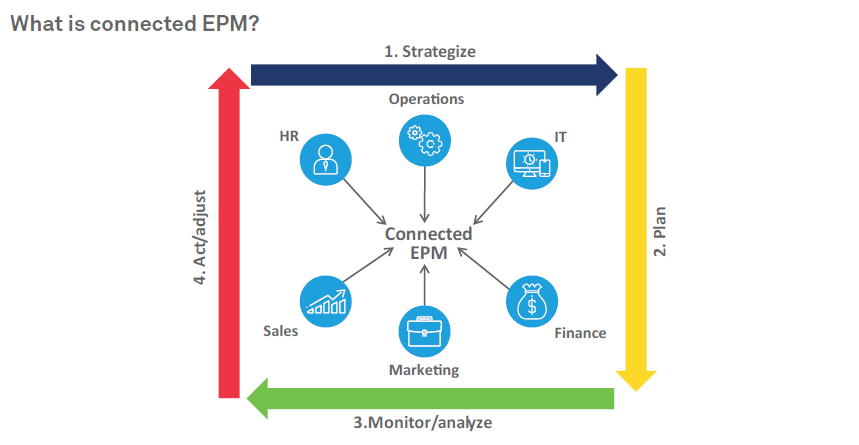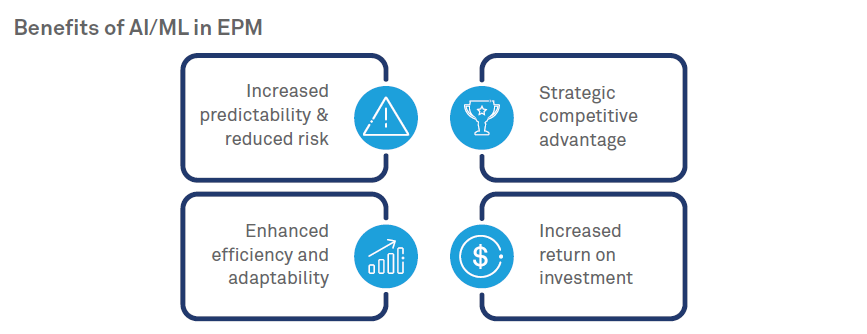Traditional enterprise planning approaches, software and technologies such as spreadsheets, legacy software systems, and in-house applications, seldom meet the complex needs of modern enterprises. It is easy to see why. They collect information in silos and require significant manual effort to consolidate, increasing the possibility of data errors and inconsistencies.
The need to understand business performance in real time in order to manage the modern enterprise makes it important to overcome existing planning systems bottlenecks. There is, therefore, a shift towards an intelligent enterprise, where systems augment management decisions with an accurate real-time view of business performance, creating a connected value chain.
Planning for the intelligent enterprise requires an integrated platform that can acquire and assimilate data from any source, analyze it at a detailed level, and provide output in the form of actionable plans for the right people, at the right time. Such a cloud-enabled platform can help users across business functions, including finance, HR, sales, supply chain and marketing, collaborate with each other in real time to develop strategic plans and drive business success.
The role of connected EPM in a modern enterprise
Connected Enterprise Performance Management (EPM) is cloud-based, enabling advanced analytics using sophisticated models and integration across platforms and functions. The objective is to automate the management of enterprise performance across a multitude of functions to augment human capability.

Figure 1: Evolution of EPM
What is the impact of EPM across the enterprise?
From a financial viewpoint: One central view of pipeline, order book, revenue, cost, and profits.
From an HR perspective: A unified view of average time for recruitment, retention of talent, compliance, star performer promotions and so on.
For supply chain: Single view of performance, and demand and supply alignment.
For sales: Comprehensive view of sales performance across geographies and accurate forecasts.
For marketing: A holistic view of marketing performance for leads, cost per lead, and resources per lead.
Connected EPM systems provide businesses with the ability to integrate data, create hierarchies, develop formulas, deliver dashboards, and include complex time dimensions. Together, these components can be defined and adapted as the business evolves.
Connected EPM systems enable several benefits such as enabling real-time capture of all data that a legacy EPM system captures and fostering quick analysis of the captured data to generate actionable insights that lead to business outcomes like improved efficiency. They also enable significant up-front cost savings through faster time to value as compared to on-premise solutions. Most importantly, they eliminate redundant workflows, yield faster response times and provide enhanced data governance.

Figure 2: Connected EPM
AI-based EPM for the Intelligent Enterprise
The intelligent enterprise promises to bring automation and augmentation to activities and decision making across an organization.
Activities such as detecting patterns, performing predictions, analyzing enormous amounts of market intelligence are useful in creating operational scenarios and identifying groundbreaking paths. Today, EPM vendors are working with several ML techniques to produce pilot studies and proof of concepts (POC) to understand the true application of augmented intelligence in planning use cases.
The POCs are designed to improve planning for specific areas such as supply planning, revenue forecasting, sales predictions, workforce optimization, and demand sensing. They are run in ‘supervised’ learning mode and can draw on internal data such as transaction records or promotion information, as well as tap into a range of external data sources such as weather or demographic information. ML algorithms iterate multiple times through the data sets with the goal of improving the accuracy of predicted outcomes. The result: deep insights for creating informed planning models.

Figure 3: Benefits of AI/ML
The AI/ML techniques help address three critical issues faced by business users across business functions – complexity, quantity and accessibility issues that make transactions time-consuming.
Complexity: As data grows in volume, it becomes increasingly complex for varied reasons. EPM systems must be upgraded to acquire information from multiple data sources coupled with unique protocols - an expensive and time-consuming process. With AI/ML, systems acquire the ability to adapt themselves, as needed.
Quantity: IoT and Big Data technologies are here to stay and it is clear that the volume of data will grow exponentially as usage of these technologies accelerates. Addressing this diversity of data to extract meaningful insights in a cost-effective way will require automation. AI/ML guarantees elimination of mundane, repetitive, manual, task-based, non-value-added work required in connected EPM systems.
Accessibility: AI/ML addresses data-accessibility challenges in two ways: by making it easier to search and use information in the system, and making the information more accessible to users across the organization.
The EPM market is witnessing the rise of many entrants who are adding AI/ML capabilities to their EPM platforms. This is creating competitive distinction between incumbents and entrants. Despite the growing capabilities across market players, major challenges exist:
• Companies need to ensure their most important asset - their people - are given enough time and resources to adapt and become equipped with requisite skills for the new opportunities that AI will create in connected planning.
• Moving into a fact-based decision-making mode changes the nature of an organization. Organizational changes are tough to manage and the intelligent enterprise will be able to absorb the changes by deploying a structured approach for workforce augmentation.
• Data quality forms the crux of successful use of AI. This means organizations will need to have better control on their data. Data mining, cleansing, integration, and management will become more important than ever.
Leveraging EPM revolution to create an intelligent enterprise
Organizations that are in the process of transforming need the support of a new EPM solution that is responsive to the needs of business users. At the same time, the EPM must keep an eye on emerging technologies like artificial intelligence, machine learning, integrated analytics and business intelligence, to accelerate data understanding and augment decision-making. Organizations in need of reliable, accurate and adaptive planning and performance management systems should proactively assess connected EPM solutions underpinned by AI to power their enterprise growth strategies.
The current revolution in the EPM marketplace addresses the ways organizations want to minimize and rationalize IT footprints and infrastructure while delivering greater value and insights. Cloud adoption, investments in emerging technologies, TCO reduction, and securing data and systems to ensure compliance must therefore become key management priorities for IT leaders looking to enable an intelligent enterprise for business leadership.
Shishir Saxena
Global Head of EPM Analytics, Wipro
Shishir with over 18 years of consulting experience helps enterprise customers across areas such as business forecasting, planning and budgeting process strategy, and its optimization. Shishir has deep domain expertise in finance and sales.
Ajinkya Pawar
Consultant - Strategy & Planning function, Data, Analytics, and AI, Wipro
Ajinkya with a deep understanding of the digital and analytics industry, including market insights, competitive landscape and related ecosystems, provides advisory services and thought leadership for building value propositions and driving cohesive strategies.